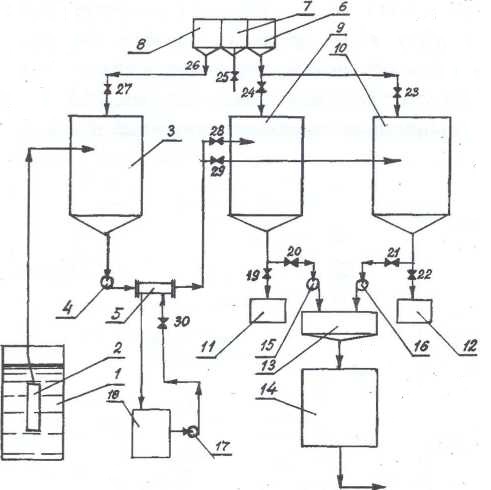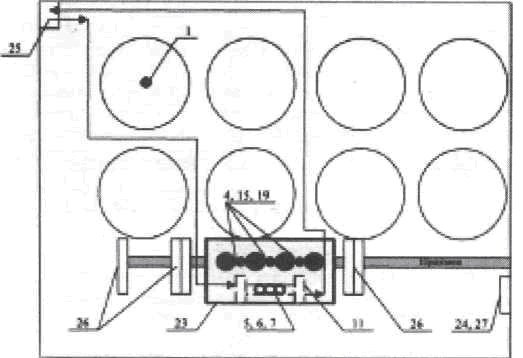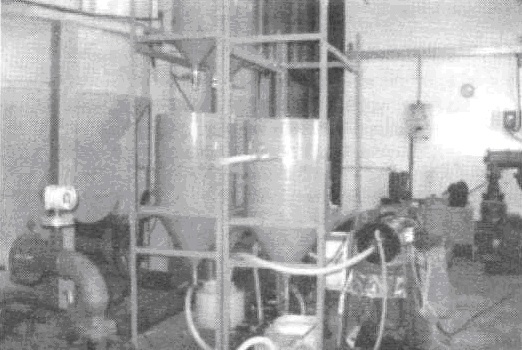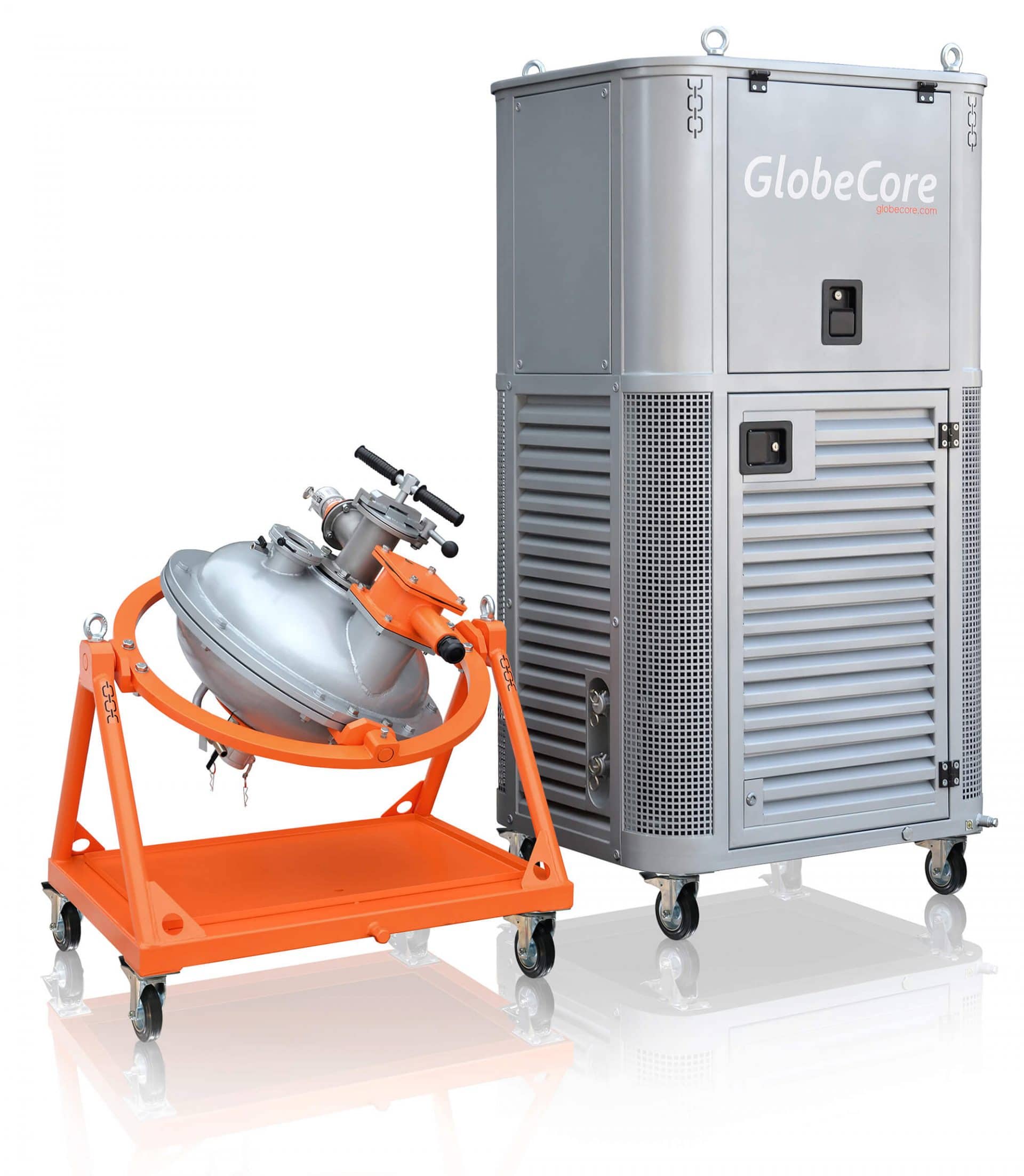Domestic wastewater of cities and countries is now overwhelming. The sewage treatment facilities have used to the limit all available reserves.
The existing technological lines that proved themselves over the years [120, 134] do not cope with the increased flow of wastewaters. The new sewage treatment facilities are expensive to build. It would seem a trifling factor, but it already makes it difficult to build a new houses.
Above, a lot has been said about the possibilities of an AVS in neutralizing many harmful discharges. Based on these data a pilot plant was designed and tested to neutralize domestic wastewater in the area of high-rise buildings. And the installation is made on a background of a well-functioning wastewater neutralization station. The collector of sewage was common. The impressive difference was in the occupied production area and in the height of the reactors (25 m). An entire existing system of reactors (8 pieces) consistently contains 450-500 m3 of suspension. The neutralization site, with the AVS, contained about 40 m3 with comparable production.. This means the speed of the suspension in the latter case is about 10 times higher.
The technological scheme of the site is shown in Fig. 165. The site contains (more by tradition) a tank-averager in the presence of a general collection.
1- fecal submersible pump for supplying initial effluents to the receiving tank
4 – wastewater pump from tank 2 to AVS; 5,6,7 – tanks for chemicals
11 – Process Activation machine (AVS)
15 – clarified water pump from the intermediate tank 12 to the settling tank
19 – pump for draining purified water from settling tank 16 to a tank for purified water
23 – shelving
24 – control panel
25 – cooling water
26 – Pumping system
27 – transformer
The tank-averager 2 and pump 4 are superfluous and the line, naturally, becomes simpler. If necessary, the productivity can be increased several times by increasing the capacity of the settling tanks 9-10 and the power of the pumps.
Fig.166. General view of the pilot machine of wastewater neutralization
Production tests showed similar degree of cleaning of cleaning of the existing station and the AVS, and in some cases the AVS gives better results (tables 65.66). An additional advantage of the AVS is that there is no need to add chlorine for disinfection.
The technology of neutralization and utilization of urban wastewater was used on a relatively small residential area.

1 – Collection of sewage; 2 – Submerged pump; 3 – Averaging tank 4, 15, 16, 17 – Pump; 5 – AVS; 6 – Sodium thiosulfate (hydrochloric acid) solution tank for chlorine binding (adjusting pH to normal); 7 – Spare tank; 8 – Tank for suspension of Ca (OH) 2 or CaOCl; 9, 10 – sedimentation tank; 11, 12 – Collection of sludge; 13 – Filter; 14 – Collection of purified water; 18 – Cooling water tank; 19-30 – Crane
With large amounts of domestic sewage, calculated in thousands of m3 / day, the basic scheme of neutralization will not change. It will will be require a more productive AVS and larger volumes of sedimentation tanks. There will be a need to create a site for the preparation of solutions (suspensions) of additives with a reserve of reagents and blocks for the utilization of sediments (granulators and dryers).
PROTOCOL
Quantitative chemical analysis (QCA) of sewage and natural waters
- Place of sampling; Input and output of biological treatment plants
- Purpose of sampling; Efficiency of work, compliance with discharge standards
- Samples taken (single, medium): Single
- Conditions for sampling: 7 * С
- Consumption of water m3 / day
- Representative of the inspection: Samples were taken and delivered by a representative of the enterprise
- Date and time of sampling, October 9, 2006
| № |
Ingredient |
Concentration, mg/dm3 |
Urban Wastewater treatment directive (UWWTD) Norm value |
||||
|
Inlet |
Biological method |
Physical- chemical method |
|||||
| QCA results | QCA error |
QCA results |
QCA error |
||||
| 1 | 2 | 3 | 4 | 5 | 6 | 7 | 8 |
| 1. | Reaction of the medium. pH | 7.1 | 7.7 | 7.8 | |||
| 2. | Odor (points) | * | 36 sm | + | 5.6 chlor | ||
| 3. | Color | grey | colorless | colorless | |||
| 4. | Clarity | 0 | >30 | + | >30 | ||
| 5 | BOD | 84.0 | 1,4 | + | 1.0 | 2 | |
| 6. | Oxidity | 29.0 | 1.0 | 5.0 | |||
| 7 | Suspended substances | 93.0 | 3.6 | + | 3.0 | ||
| 8. | Ammonia nitrogen | 38,0 | 1.3 | + | 0.41 | 0.5 | |
| 9. | Nitrite ion | 0.02 | * | 0,055 | + | 0.02 | 0.08 |
| 10. | Nitrate ion | 0,17 | 21.0 | + | 4.1 | 40 | |
| 11. | Phosphates (by P) | 2.1 | 1.7 | + | 0.2 | 0.2 | |
| 12. | Chlorides | 200.0 | 100,0 | 570.0 | 300 | ||
| 13 | Sulphites | 20.0 | 18,0 | 90.0 | 100 | ||
| 14. | Total iron | 1,2 | 0,17 | 0.3 | 0.1 | ||
| 15. | Anionic surfactant | 0,095 | 0.039 | 0.025 | 0.1 | ||
| 16. | Petroleum products | 0.36 | 0.035 | 0.006 0.05 | |||
Environmental issues in domestic wastewater treatment
The traditional technology of domestic wastewater treatment disinfection purified water with chlorine in very large quantities, and compacts the accumulated sludge in large tanks during a long sedimentation time. At the same time, it doesn’t use neutralization products.
The AVS technology does not require chlorine for disinfection of purified water. When using lime chlorine, the chlorine is completely neutralized.
Neutralized sludge contains a significant amount of Ca (OH)2, phosphorus compounds and a number of other components, including oxidized fats, in the form of calcium soap, which is almost insoluble in water.
Thus, the sludge does not contain either organic or mineral components harmful to the environment. The content of calcium makes the sludge a very useful material for the liming of acidic soils.. Therefore, the condensed sludge can be exported directly to agricultural land with great benefit.
The purified water after treatment in the AVS becomes active, and has a very favorable effect on the growth and development of plants.
The pumpkin fruits watered with water treated in AVS were 2.0-2.5 times more in weight, and 1-2 weeks earlier ripening than l, watered artesian water. A similar phenomenon is noted in cultivation of corn, millet, flowers and other crops.
From the above it can be ascertained that the result of domestic wastewater treatment, is purified and deactivated water and sludge that have a commercial value. This eliminates the costs of sludge disposal and allows discharge of purified water into natural waterways.




 AVS-100 Mixing Machine. ...
AVS-100 Mixing Machine. ... AVS-150 Chemical Mixing ...
AVS-150 Chemical Mixing ...